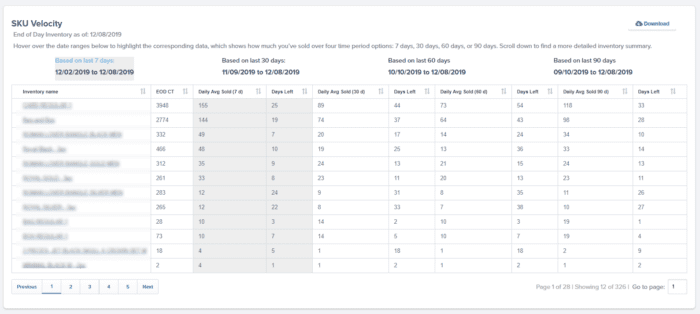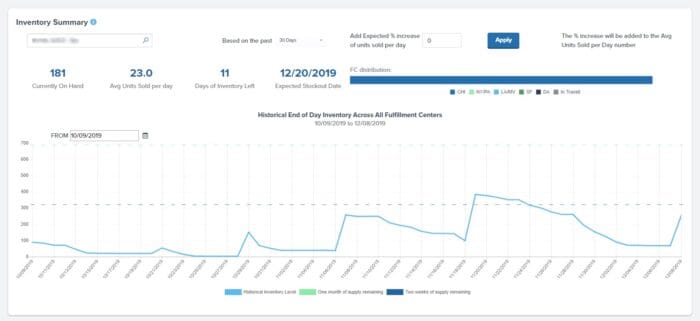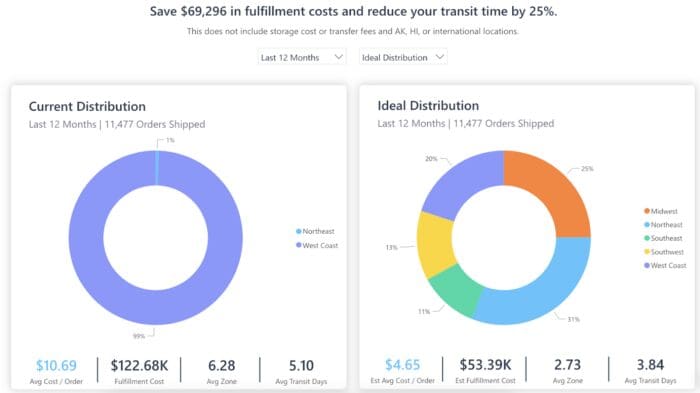Table of Contents
** Minutes
What is minimum order quantity (MOQ)?
Why do suppliers use minimum order quantities?
How do MOQs affect ecommerce brands?
How to calculate minimum order quantity in 4 steps
6 tips to make the most of minimum order quantities
Many ecommerce businesses purchase raw materials or finished goods from manufacturers. Ideally, these brands want to purchase just enough inventory to meet demand.
The bad news? Many suppliers institute a minimum order quantity (MOQ). This means that brands must commit to buying a certain amount of stock, because it’s more cost-effective for manufacturers to mass-produce items.
Your brand’s ideal unit count or reorder quantity may not match your manufacturer’s MOQ. However, there are benefits to MOQs – and ways to make them work for you.
In this article, we’ll give you an overview of minimum order quantity, take a look at some vital factors to consider when calculating MOQ requirements, and provide tips on how to make the most of MOQs.
What is minimum order quantity (MOQ)?
A minimum order quantity is the minimum number of units that a business will sell in a single order.
For example, if a customer wants to place an order with a business that has an MOQ of 10 units, the customer must purchase at least 10 units in that order for the business to accept and fulfil it.
MOQs are instituted so that the business producing or selling the units can cover their costs and make a profit from the production or sale.
Types of MOQ
In general, there are two types of MOQs: supplier-set MOQs and brand-set MOQs.
Supplier MOQs are MOQs that suppliers set, and then present to the brands that are considering purchasing from them. Suppliers set these MOQs to make sure that they don’t lose money on a production run.
For example, say a supplier makes candles, and a nearby boutique orders 10 candles from them. The supplier must buy the raw materials and pay for the labour to make just the 10 candles, which altogether costs $500. If the supplier sells each candle for $8, they only make $80, which is not nearly enough to offset the $500 production cost or see any profit.
However, if the boutique orders a larger amount of candles – say, 50 candles – the supplier can purchase raw materials in bulk at a much cheaper price. This lowers their production costs to just $200. By selling 50 candles at just $6 apiece, the supplier still nets $300, which is enough to cover production costs and secure some profit for their effort.
Brands can also institute MOQs for end customers, though this is far less common. For instance, a brand may have an MOQ requirement for wholesale or retail partnerships, where they require a minimum of 50 units or $500 worth of product to be purchased together.
Why do suppliers use minimum order quantities?
If MOQs tend to annoy ecommerce brands, why do suppliers have them? The reasons have less to do with brand satisfaction, and much more to do with the supplier’s bottom line.
Cost reduction
As mentioned above, instituting MOQs enables suppliers to purchase raw materials in bulk, which is usually more cost-effective. If a supplier’s process is already designed for mass-production, they may not even incur much more in the way of labour costs for larger orders than smaller orders.
Some suppliers don’t even purchase raw materials until a customer has made their purchase. This lets suppliers avoid spending money to produce inventory that doesn’t get sold – and since materials and finished goods aren’t sitting on shelves until they’re sold, the supplier will have lower holding costs.
Higher profits
MOQs help ensure a profit for suppliers on every production run. Suppliers may adjust the prices of goods and MOQs over time to widen or shrink profit margins.
Inventory management and control
Suppliers don’t want to be stuck with goods they can’t sell, either. To keep their own inventory moving through their supply chain (as opposed to sitting on shelves), suppliers may require brands to commit to purchasing a certain amount of stock. This allows the suppliers to manage their inventory more effectively, and keep inventory levels in check.
How do MOQs affect ecommerce brands?
MOQs can make inventory management more complicated for ecommerce brands, but they sometimes offer benefits as well. Here are some of the most common upsides and downsides of MOQs.
Pro: Cost-savings for large purchases
Many suppliers with MOQs choose to pass some of the cost-savings they see onto their customers. Purchasing goods at the supplier’s bulk MOQ may give a merchant the best price per unit – so depending on the product’s shelf life and the amount of demand for the product, buying at the MOQ amount may be the most economical option.
Pro: Stronger business relationships
Discussing MOQs with suppliers and negotiating potential solutions or compromises can be difficult, but it is usually worth it. These conversations can strengthen the supplier-customer relationship, which is key to a brand’s long-term success.
Con: Inventory management challenges
While MOQs typically benefit suppliers, they can make it difficult for the brands to balance their inventories.
For instance, a supplier may require an ecommerce brand to purchase 100 units of a particular inventory item – but if the brand is still growing, it may not be able to sell through all 100 units. This could leave them with deadstock, and increase their holding costs.
For this reason, merchants working with suppliers that have MOQs will need to take extra care when forecasting demand, find storage solutions that accommodate larger quantities of inventory, or simply find a different supplier.
Con: Cash flow considerations
Having too much of your brand’s capital tied up in inventory can create cash flow problems. As a result, having to purchase inventory in bulk because of a supplier’s MOQ can leave you short on cash. It may also be longer before you see ROI on your inventory purchase, as the more units you have, the longer it may take you to sell them all.
How to calculate minimum order quantity in 4 steps
There is no one right MOQ amount, as many businesses have different requirements. Of course, ecommerce brands and suppliers usually face a tradeoff: they can either set a higher MOQ at a lower price, or pay a higher price per unit for a lower MOQ. While there isn’t a go-to formula for calculating minimum order quantity, you can use the steps below as a starting point.
1. Determine demand
Before a supplier makes any stock, and before a merchant buys any stock, both parties need to know how much stock they plan on selling. Good demand forecasting takes product type, competition, seasonality, and other factors into account to produce an estimate for how many units a merchant or supplier will sell. This data can help inform your next purchase order.
As an ecommerce merchant, you may find that the supplier’s minimum order quantity isn’t too far off from what you plan to sell through.
For example, say your brand’s demand forecast for the upcoming quarter predicts that you’ll sell 900 stock units. If your supplier has an MOQ of 1,000 units, this difference is manageable. If the product is small (like a bracelet), 100 units may not take much more room to store – and it never hurts to have some safety stock in case demand spikes.
On the other hand, you may find that your supplier’s MOQ is much higher than your expected sales. If your supplier’s MOQ is 1,000 units, but your brand only expects to sell 400 units, you will need to negotiate with your supplier to find a solution.
2. Calculate your break-even point
Both suppliers and merchants seeking to establish their own MOQs will need to know their break-even point.
The break-even point is the per-unit price that results in no profit or loss for the business. Usually, suppliers and brands determine this price, and then set their MOQs above it to ensure they make a profit.
For instance, if it costs a supplier $0.40 to make a single unit of product, the break-even point would be $0.40. If an ecommerce brand spends $100 to purchase 50 units of inventory from a supplier, the breakeven point would be $2.
3. Understand your holding costs
Some products are more expensive to store than others (due to size, duration of storage, and special warehousing requirements). It’s financially beneficial to ensure such items are not kept in your inventory for too long.
Your inventory holding cost is the true cost of storing all of your products and something you must consider before investing too heavily in inventory. This means that suppliers may want to wait until a purchase is made before purchasing and storing raw materials or finished goods, and merchants may want to think twice before complying with high MOQs.
4. Come up with your MOQ
Having gathered all this information, suppliers and merchants are ready to set an MOQ.
Say that your brand:
- Expects to sell 500 units in the next quarter
- Has a break-even point of $7
- Pays $3 per quarter to store 1 unit of your product
If you procure and store the 500 units of inventory you expect to sell, it costs your business $5,000. To cover this investment and secure profit, you’ll need to sell each unit for more than $10.
How high you set the price will impact how high your MOQ will be, and vice versa. For example, your brand could charge $12 per unit. At that price, you’ll need to sell at least 417 units to make a profit at all – any less, and you will have lost money. Setting an MOQ higher than 417 will maximise your profit.
Alternatively, your brand could charge $20 per unit. Because the price per unit is higher, you won’t have to sell as many units to make a profit, so your MOQ can be lower. In this specific case, you’d have to sell just 251 units to turn a profit, so setting an MOQ of 260 will help you make money from the sale.
6 tips to make the most of minimum order quantities
MOQ terms may seem awful when you’re on the purchasing side, but awesome when you’re on the selling side. Many ecommerce businesses work with manufacturers that have minimum order quantity requirements in place, and some brands will be in the position of implementing their own MOQs through wholesale partnerships or minimum spend thresholds.
No matter where you are, here are some tips on how to make the most of MOQs.
Incentivize a higher spend on your orders
If you’re getting into wholesale or retail, you can require MOQs for bulk buyers to help ensure retailers pay you a minimum amount. In exchange for a minimum spend, you may choose to offer order volume discounts, where you charge the retailer less per unit in exchange for a higher guaranteed overall spend.
Also, you can adjust the prices to help incentivize higher spend. To do this, you need to set MOQ based on volume or cost. For low-cost items, you need to set a higher MOQ. This ensures you make a profit. For higher-cost items, you can afford to set a lower MOQ. Following this strategy helps you make a profit, no matter if you sell small or large quantities.
Similarly, you can test this strategy for your direct-to-consumer orders by requiring a minimum amount of products to be sold (e.g., 3 bottles of a beverage each priced at $10 to ensure your order value is at least $30) to cover customer acquisition costs and the cost of goods sold.
You can also try this with a free shipping minimum spend threshold, where you require customers to spend a certain amount of money to qualify for free shipping.
Eliminate slow-moving SKUs
Oftentimes, brands will have more SKUs than they should, and they’ll be stuck paying for storage and doling out cash to fulfil MOQs for products that don’t sell or drive revenue.
Keeping your SKU count simple and minimal helps with inventory forecasting. The difference between 20 and 40 SKUs can be hard enough to manage, let alone managing up to 400 SKUs. It’s easy to overestimate the use of new colours and slight variations in products. A lot of the time for ecommerce store experiences, having more than three options is too much to think about.
Whether you have a ton of SKUs or just a few, it’s always important to monitor how they’re selling. 3PL partners like ShipBob leverage software that will track your SKU performance for you, so you can always know how quickly SKUs are selling and how much of each SKU you have left.

Boost inventory turnover
Ordering excess inventory incentivizes you to have a higher inventory turnover ratio, meaning there’s pressure to sell your inventory quicker because you invested more cash upfront.
If you’re already bound by a supplier MOQ and end up with surplus inventory, seek out creative strategies like running flash sales, bundling extra SKUs with other products, or including them as free gifts in orders. This will help you deplete inventory while still getting some value out of the extra inventory.
If the minimum order quantity is too high and you haven’t proven your business model or product-market fit yet, it’s best to look for a different supplier with a lower MOQ (or none at all). Otherwise, you may end up investing too much money in inventory that may not sell – all while paying higher warehousing costs.
Find other suppliers or distributors
If your manufacturer has a higher MOQ than you’d like, you can always attempt to negotiate with them. There’s no harm in trying! If the manufacturer doesn’t budge and still requires an MOQ that’s too high for you, consider working with a trading company or wholesale distributor, the middlemen who buy in bulk from a manufacturer and resell smaller quantities to others.
Ask other questions
You’re allowed to get creative in your conversations with manufacturers and suppliers. Try rephrasing questions or thinking outside the box:
For example, you could ask a manufacturer if they will let you ‘mix and match’ or order several different products to hit an MOQ, rather than only identical units. You could also ask the manufacturer if they have leftover products from other customers who have canceled orders and thus, don’t require them to produce anything from scratch.
Focus on relationships
It’s possible to start with good terms from a manufacturer, but it becomes even easier over time especially when you build a good relationship with them.
Here’s how it works:
- You sell your manufacturer your vision and get them bought in.
- Your ecommerce business keeps growing.
- Your manufacturer is happy as they keep making money alongside your growth.
- You pay them on time and order more from them.
- Over time, they may offer better terms and be more flexible with you.
We’re all human and want to succeed. Over everything else, remember:
- View it as a partnership and not a transactional relationship. If a manufacturer isn’t willing to work with you, they might be the wrong partner.
- Treat people well no matter what. Partnerships are very important, and can even be irreplaceable.
Easily implement minimum order quantity with ShipBob
ShipBob is a leading omnifulfillment platform that fulfils DTC and B2B ecommerce orders for merchants.
ShipBob’s software, algorithm, and analytics work together to help you make better data-driven decisions to optimise your supply chain, and make the best of supplier MOQs.
1. Built-in inventory management
ShipBob offers powerful technology with built-in inventory management software features, including the ability to set reorder points for individual SKUs. ShipBob also has a free analytics tool that provides advanced data visualizations, inventory forecasting, real-time inventory counts, and more. Get answers to questions like:
- What were my historical stock levels at any point in time in any location?
- How many days do I have left until a SKU will be out of stock?
- By when do I need to reorder inventory for each product?
- How often is each product sold across channels?
- If I run a sale on my site, how will this affect my available inventory levels?
- How does product demand compare to previous periods?
- How are my sales affected by different seasons and months?
- What are my best-selling items?
- Which items are not generating sales and incurring high ecommerce warehousing fees?
- What is my average storage cost per unit?
- What is the total number of bins/shelves/pallets I’m being charged for?
- And more!
“ShipBob’s reporting is very robust and meets all of our needs. We get visibility into receiving, order volume, SKU availability – everything from inbounds and inventory transactions to individual order statuses (whether it’s on hold, in processing, an exception order, and other detailed descriptions). All this data is real-time, meaning that we’re always seeing the most accurate, up-to-date information. Having this real-time data is crucial for my team, so the fact that there’s not hours of lag time waiting for data to update is huge.”
Ryan Steffenson, Senior Manager, Channel Operations at Tonies

2. Distributed inventory
ShipBob has dozens of strategically-placed fulfilment centres across the United States (and even some abroad). We let you distribute your inventory across multiple warehouses to optimise order delivery times and shipping costs. When a customer places an order, it will be picked, packaged, and shipped from the nearest location. The reduction in shipping costs can help offset the higher spend due to MOQ requirements in some cases.

“Because ShipBob has multiple fulfilment centres across the US, we’re able to store and ship our products close to our customers, which helps us bring down shipping costs regardless of where we’re shipping throughout the country.”
Kayleigh Christina, Co-Founder and CMO of CLEARSTEM
3. Wholesale shipping capabilities
With ShipBob, online store owners can create and manage wholesale orders entirely from one central dashboard. ShipBob supports automated, EDDI-compliant retail dropshipping and distribution for dozens of major retailers and marketplaces, so you can achieve seamless omnichannel fulfilment.
“Having the same partner handle both direct-to-consumer and business-to-business orders is crucial. Managing separate inventory pools for DTC and wholesale can be challenging, making it essential to maintain unified inventory across all channels.
ShipBob enables us to serve both our direct-to-consumer (DTC) customers and our business-to-business (B2B) clients, which include Nordstrom, Target, Bloomingdales, and Saks. This encompasses direct vendor shipments and B2B wholesale operations, all managed seamlessly across ShipBob’s warehouse network.”
Ali Shahid, COO of Our Place
To learn how ShipBob can help with fulfilment, storage, and inventory management, click the button below to learn if we’d be a good mutual fit.
Minimum order quantity FAQs
Ecommerce store owners have many questions regarding minimum order quantity requirements, and rightfully so. We’ve provided answers below to some common FAQs.
What is a minimum order?
A minimum order is the smallest amount of items a business agrees to sell to a customer. Businesses willing to sell customers a single item at a time would have a minimum order of one. Other businesses will only allow customers to purchase in larger quantities, and therefore have higher minimum orders.
How do you find the minimum order quantity?
There is no standard formula for calculating minimum order quantity. To determine the right MOQ for your business, it’s worth forecasting demand, doing scenario planning, and calculating volume discounts and inventory carrying costs. You can then decide the lowest quantity that works for your business.
When should minimum order quantities be applied?
If you are a manufacturer who needs to produce products, then enforcing MOQ terms is important to stabilize your profit margin and make it worthwhile to produce in the first place.
Ecommerce businesses that supply products typically sold in sets, such as kitchenware, should also have minimum order quotas through packaging or bundling to increase average order value, and they could also explore MOQs for wholesale partners.
What is MOQ in the supply chain?
In the ecommerce supply chain, MOQ is the minimum number of units of a single SKU that a business must purchase from a manufacturer or seller in one production run or purchase order.
What is the difference between MOQ and EOQ?
Economic order quantity (EOQ) is an equation used to determine the ideal quantity of inventory to stock in your warehouse so that you don’t spend too much on storage but also don’t run out of products. MOQ is the amount of product a supplier or seller requires a purchaser to buy at one time. An MOQ can cause an ecommerce business to purchase more inventory than they need at one time, causing them to be nowhere near their EOQ.
What’s an effective way to handle MOQ rules enforced by a supplier while doing order planning?
If your supplier’s MOQ is too high for your brand, you can try to negotiate a compromise with said supplier. You may convince them to let you ‘mix and match’, ordering several different products to hit an MOQ (rather than only identical units), or to sell you leftover products from canceled orders rather than producing new ones from scratch.
If you and your supplier cannot come to an agreement, consider whether it is more advantageous to deal with the surplus inventory, or to find a different supplier.




